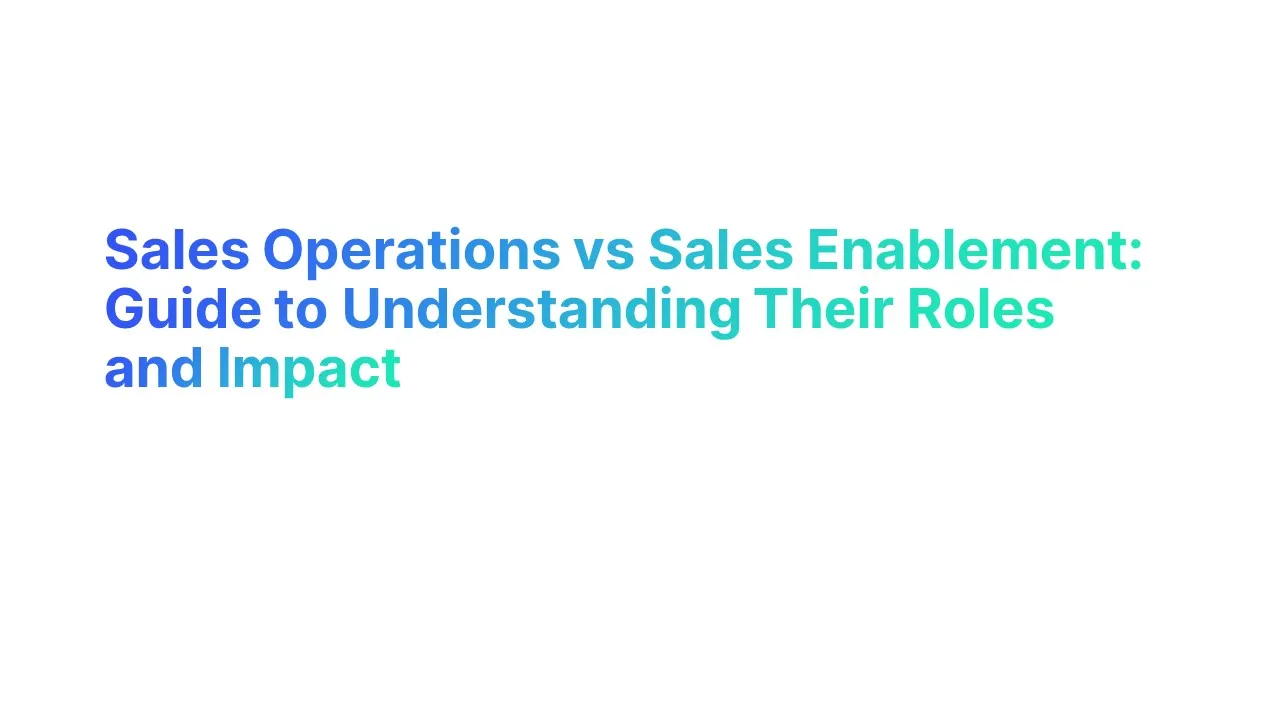Introduction to Sales Enablement and Sales Operations

What is Sales Operations
Sales Operations refers to the division within a business that is focused on increasing the efficiency and effectiveness of the sales team. This function is responsible for managing tools, technology, processes, and administrative tasks to support direct sales activities.
It plays a crucial role in strategy formulation, forecasting, handling compensation plans, and overall sales optimization.
Why You Need Sales Operations
1. Efficiency Optimization: Sales operations streamline processes, reducing time spent on administrative tasks, allowing sales reps to focus more on selling.
2. Enhanced Decision-Making: With precise data analysis and CRM management, sales operations provide insights that lead to informed decision-making, improving sales strategies and outcomes.
3. Improved Sales Forecasting: Through detailed analysis and management of sales data, sales operations enhance the accuracy of sales forecasting, crucial for planning and resource allocation.
4. Strategic Alignment: Sales operations ensure that the sales team's goals align with the broader business objectives, facilitating more cohesive efforts across departments.
Statistics for Sales Operations
- Companies with dedicated sales operations teams have seen a 15% increase in sales productivity (Source: Sales Benchmark Index).
- Organizations that align sales and marketing through effective sales operations report 36% higher customer retention rates (Source: MarketingProfs).
- Effective sales operations can lead to a 20% decrease in sales cycle length, optimizing the sales process significantly (Source: Aberdeen Group).
What is Sales Enablement
Sales Enablement is a strategic, ongoing process that equips all client-facing employees with the ability to consistently and systematically have a valuable conversation with the right set of customer stakeholders at each stage of the customer's problem-solving life cycle to optimize the return of investment of the selling system.
This process involves providing sales teams with the tools, information, content, and training they need to sell effectively.
Why You Need Sales Enablement
1. Increased Sales Effectiveness: By ensuring sales teams have ready access to the right tools and content at the right time, sales enablement boosts the effectiveness of sales interactions with prospects and customers.
2. Streamlined Training and Onboarding: Sales enablement facilitates faster onboarding of new sales reps by providing structured training and ready access to learning materials, significantly reducing the time it takes for new reps to become productive.
3. Enhanced Content Utilization: It ensures that marketing materials and sales collateral are used effectively to engage prospects, aligning marketing and sales efforts for better message consistency and delivery.
4. Improved Sales Engagement: With tailored content and strategic outreach tools, sales enablement helps sales representatives engage more meaningfully with prospects, improving conversion rates and customer engagement.
Statistics for Credibility:
- Organizations with a sales enablement strategy have seen a 32% increase in sales team quota attainment compared to those without (Source: CSO Insights).
- Companies that implement sales enablement practices report a 23% higher lead conversion rate (Source: Aberdeen Group).
- Businesses with dedicated sales enablement programs experience 14% better sales and marketing alignment (Source: SiriusDecisions).
Sales Operations vs Sales Enablement: Understanding the Key Differences

When looking at the functions within a sales organization, distinguishing between sales operations and sales enablement can often be confusing, as both roles significantly overlap yet cater to different aspects of the sales process.
Understanding the key differences between these two functions is crucial for optimizing both strategies and operations within a sales team.
Sales Operations
Sales Operations primarily focuses on the efficiency and effectiveness of a sales team. This function is the backbone of the sales department, ensuring that the infrastructure and operations are set up to allow sales professionals to succeed in their roles.
- Process Optimization: Sales operations streamline internal processes, making it easy for sales teams to follow through on their tasks with minimal friction. This includes managing CRM systems, data analysis, and performance tracking.
- Strategic Planning and Forecasting: They play a crucial role in forecasting and strategic planning, using historical data to predict future sales trends and set achievable targets.
- Metrics and Performance Analysis: Sales operations are responsible for defining and tracking key performance indicators (KPIs) that help measure the effectiveness of sales strategies.
Sales Enablement
In contrast, sales enablement focuses on equipping sales teams with the right tools, content, and information to effectively engage with customers and close deals.
- Training and Development: Sales enablement provides ongoing training and development to ensure that sales teams possess the necessary skills and knowledge. This includes onboarding new sales representatives and keeping the team updated on the best practices.
- Content Provision: It ensures that the sales team has access to up-to-date sales content and collateral that resonates with different stages of the buyer's journey.
- Tools and Resources: Sales enablement selects and implements tools that assist sales teams in engaging with prospects effectively, such as sales engagement platforms or content management systems.
How Can Sales Enablement and Sales Operations Work Together?

Sales Enablement and Sales Operations are distinct functions within a sales organization, but when they work together effectively, they can significantly enhance overall sales performance. Here’s how these two functions can collaborate:
1. Aligning Goals and Strategies:
- Joint Planning Sessions: Regularly hold joint strategy sessions involving sales leaders, sales managers, and representatives from both the sales enablement team and the sales operations team to ensure alignment on goals. This helps understand each team's initiatives and determines how these can complement each other.
- Unified Metrics: Both teams should agree on common metrics and KPIs to measure the effectiveness of sales operations and sales enablement initiatives. This collaboration helps in creating a cohesive strategy that supports the sales process from both an operational and an engagement perspective.
2. Data Sharing and Analysis:
- Shared Insights: Sales operations, often referred to as 'sales ops', manage data analytics and performance metrics. Sharing these insights with the sales enablement team can help tailor sales training programs and content creation to address specific weaknesses or capitalize on emerging opportunities.
- Feedback Loop: The sales enablement team can provide feedback from the sales and marketing teams and customers back to the sales operations team to refine processes and tools, ensuring both teams are adapting to real-world needs and outcomes.
3. Resource and Tool Integration:
- Technology Stack Coordination: Ensure that sales enablement technology and platforms selected by the sales enablement team are well integrated into the CRM systems and other tools managed by the sales operations team. This reduces friction and enhances the efficiency of sales reps.
- Consolidated Tool Training: Sales enablement can take charge of training sessions that not only cover effective selling techniques but also how to maximize the use of operational tools provided by the sales operations team.
4. Cross-Functional Support and Communication:
- Regular Interdepartmental Meetings: Establish a routine of meetings where both teams, along with sales managers and sales leaders, can discuss ongoing activities, share updates, and troubleshoot issues together.
- Joint Performance Reviews: Conducting joint reviews can help both teams understand the impact of their collaboration on sales outcomes and refine their approach accordingly.
5. Coordinated Content and Messaging:
- Unified Sales Messaging: The sales operations team provides analytics on what messaging and content have performed best. The sales enablement team uses this data to develop training materials and sales collateral that are more aligned with what works, ensuring consistency across all touchpoints.
Roles and Responsibilities of Sales Enablement Teams & Sales Operations Teams
Future Trends in Sales Operations and Enablement

1. AI is being used to predict customer behavior and identify the best opportunities. Companies using AI for sales report a 50% increase in leads and appointments (Source: Harvard Business Review).
2. Sales operations are increasingly adopting automation to handle routine tasks. This allows sales reps to focus more on selling, boosting productivity by 30% (Source: McKinsey & Company).
3. Sales enablement is leveraging data to tailor interactions and content to individual customers. Personalized content can increase sales by 20% (Source: Epsilon).
4. With a greater focus on customer experience, sales operations teams are adopting customer journey mapping to ensure seamless interactions, leading to a 15% increase in customer retention (Source: Gartner).
5. Tools that integrate sales and marketing data are becoming essential, facilitating better collaboration and more cohesive strategies. Companies with strong sales and marketing alignment achieve a 36% higher customer retention rate and 38% higher sales win rates (Source: MarketingProfs).
6. Sales enablement teams are working closely with marketing to ensure content is relevant and timely, supporting the entire sales funnel.
7. As data breaches become more common, sales operations must ensure that customer data is protected. Investments in cybersecurity are expected to grow by 10% annually (Source: IDC).
8. Adherence to data protection regulations like GDPR is critical, requiring ongoing updates to policies and training for sales teams.
9. The shift to remote and hybrid work models has accelerated, with 70% of companies planning to adopt a hybrid work model permanently (Source: Gartner). Sales enablement must adapt training and tools to support remote sales teams effectively.
10. Sales operations are investing in virtual selling tools to facilitate remote interactions, improving reach and flexibility.
11. The use of advanced analytics tools helps in tracking performance and identifying areas for improvement. Companies using advanced analytics see a 5-6% increase in productivity (Source: Bain & Company).
12. Providing sales teams with real-time data access can significantly improve decision-making and responsiveness.
Conclusion Thoughts
Navigating the distinctions between sales operations and sales enablement is crucial for any organization striving to maximize its sales effectiveness. Sales operations focus on optimizing the efficiency and infrastructure necessary for sales success, underpinning strategic decision-making and process enhancement.
Meanwhile, sales enablement enriches this framework by ensuring sales teams are equipped with the right tools, content, and training, directly boosting sales readiness and customer engagement. When integrated effectively, both functions not only streamline sales processes but also fortify the overall sales strategy, leading to sustained business growth and a competitive edge in the market. Understanding and leveraging the unique roles of each will be key to enhancing your company's sales performance in today's dynamic business environment.





.jpg)

.jpg)
